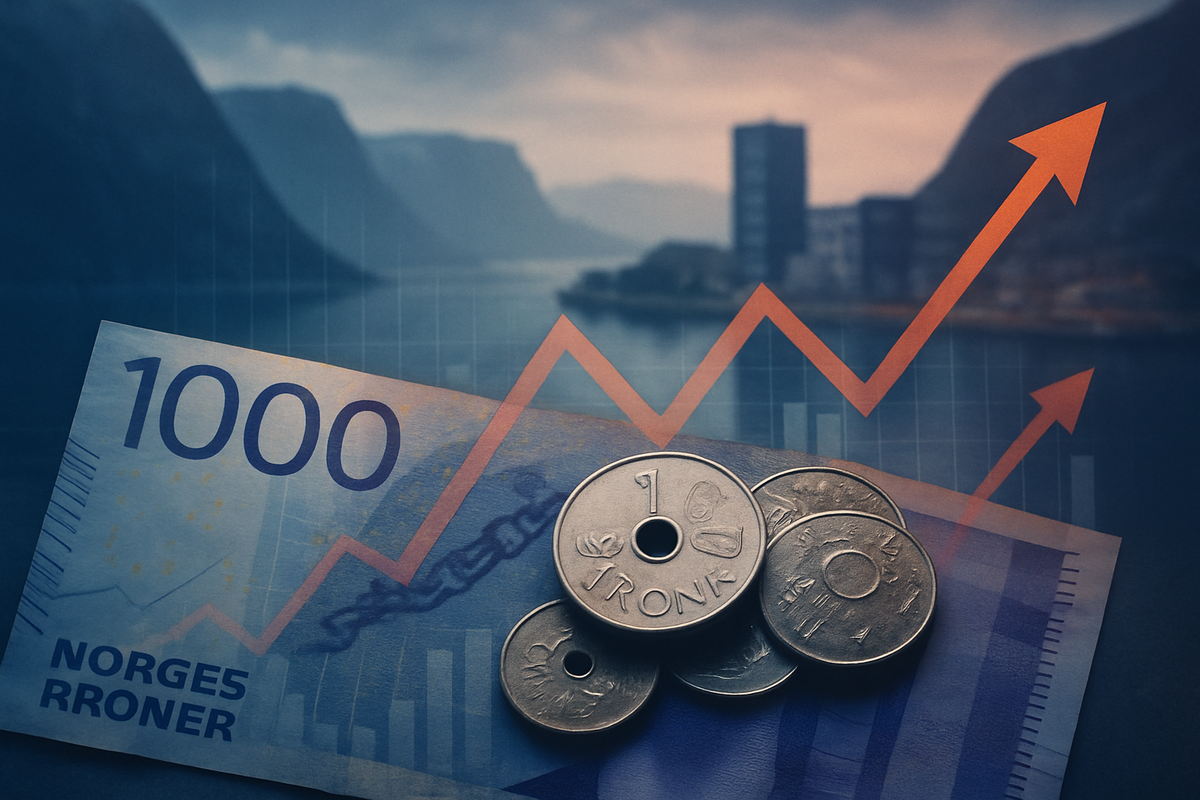
Oslo, Norway – October 10, 2025 – Norway's annual inflation rate for September 2025 climbed to 3.6%, surpassing analyst estimates of 3.5% and marking its highest level in seven months. This unexpected acceleration in price growth suggests stronger-than-expected inflationary pressures within the Norwegian economy, immediately casting a shadow over Norges Bank's carefully calibrated plans for monetary easing. The data complicates the central bank's efforts to guide inflation towards its 2% target while supporting economic stability.
The inflation surprise signals that the battle against rising prices is far from over in Norway. While the headline figure grabbed attention, the Consumer Price Index adjusted for tax changes and excluding energy products (CPI-ATE), often considered a measure of core inflation, showed a slight moderation to 3.0% year-on-year, a fraction below the 3.1% forecast. This mixed signal presents a delicate challenge for policymakers, who must weigh persistent headline pressures against a potentially easing underlying trend.
Detailed Coverage: Unpacking Norway's Inflationary Surge
The 3.6% increase in the Consumer Price Index (CPI) from September 2024 to September 2025 was primarily driven by accelerated price growth in food and non-alcoholic beverages, which surged by 6.3% (up from 5.4% in August), and transport, increasing by 2.9% (from 2.7% in August). These sectors indicate robust domestic demand and potentially higher input costs. Conversely, inflation eased in areas like housing and utilities (6.2%), recreation and culture (2.5%), and restaurants and hotels (3.2%), suggesting some moderation in service-related price increases. On a monthly basis, the CPI rose by 0.4% from August to September, exceeding expectations of a 0.3% rise, while the CPI-ATE only increased by 0.2% monthly, below the anticipated 0.4%.
This announcement by Statistics Norway (SSB) on October 10, 2025, comes after a period of careful monetary management by Norges Bank, Norway's central bank. The bank had initiated a "cautious normalisation" of its monetary policy in June 2025, implementing its first interest rate cut in five years, reducing the policy rate from 4.5% to 4.25%. This was followed by another 25 basis point cut in September 2025, bringing the rate to 4.0%. Despite these cuts, Norges Bank had simultaneously revised upwards its projected interest rate path, signaling a slower pace of future reductions, acknowledging that inflation might remain elevated for longer than initially projected. The September 2025 inflation data now adds further complexity to this already nuanced strategy.
Key players and stakeholders involved in this economic development include Norges Bank, which is tasked with maintaining price stability, and Statistics Norway (SSB), the official source of the inflation data. Industries such as food and non-alcoholic beverages and transport are central to the current inflationary pressures, indicating challenges within their supply chains or strong consumer demand. The housing and utilities sector also remains a significant, albeit slightly moderating, component of overall price levels.
Initial market reactions saw the Norwegian Krone (NOK) trading largely unchanged against the euro immediately following the core inflation data release, as analysts from ING Think noted the data did not significantly deviate from consensus to trigger a major currency repricing. However, a general softening of risk sentiment continues to keep the NOK vulnerable. The Oslo Stock Exchange (OSE) experienced heightened volatility, particularly in sectors sensitive to interest rate changes like financials and consumer goods, as investors adjusted their expectations for Norges Bank's next moves. The mixed signals from headline and core inflation are likely to fuel ongoing debate among analysts regarding the central bank's future policy trajectory.
Companies Navigating the Inflationary Tides
Norway's 3.6% inflation rate and Norges Bank's cautious monetary policy, hinting at potentially "higher-for-longer" interest rates or a slower pace of cuts, will create distinct winners and losers among public companies listed on the Oslo Stock Exchange (OSE).
Potential Winners are generally companies with strong pricing power, exposure to commodity markets, or robust balance sheets with low debt.
- Oil & Gas Producers like Equinor ASA (OSE: EQNR), Aker BP ASA (OSE: AKERBP), and Vår Energi ASA (OSE: VAR) often benefit from higher energy prices, which contribute to inflation. A potentially weaker Norwegian Krone could also boost their NOK-denominated revenues. Their substantial cash flows typically allow them to manage debt even in a higher interest rate environment.
- Banks and Financial Institutions such as DNB Bank ASA (OSE: DNB) and Storebrand ASA (OSE: STB) generally see improved profitability from higher interest rates, as their net interest margins expand. A "higher-for-longer" scenario directly translates to better earnings, assuming loan defaults remain manageable. DNB Bank ASA, for instance, saw a rise of 2.79% on October 10, 2025, reflecting this positive outlook.
- Certain Industrial & Defense Companies like Kongsberg Gruppen ASA (OSE: KOG) with strong order books and specialized products, particularly those benefiting from global trends like increased defense spending, can maintain pricing power and are less directly exposed to domestic consumer spending.
Potential Losers are typically companies with high debt, significant exposure to discretionary consumer spending, or those unable to easily pass on rising input costs.
- Real Estate and Construction Companies, including AF Gruppen ASA (OSE: AFG), are highly sensitive to interest rates. Higher borrowing costs for developers and homebuyers can dampen demand, reduce property values, and increase financing expenses. Norway's households have high debt-to-income ratios, largely tied to mortgages, making them vulnerable to rising rates.
- Consumer Discretionary Companies (e.g., in retailing, travel & leisure, parts of media, and automotive sectors) face headwinds as inflation erodes purchasing power and higher interest rates make borrowing more expensive. Consumers tend to cut back on non-essential goods and services, leading to reduced sales volumes and pressure on profit margins if companies cannot fully pass on increased operating costs.
- Companies with High Operational Gearing and Fixed Input Costs (e.g., some manufacturing or transport companies) will see squeezed margins if they rely heavily on specific raw materials, energy, or transportation, and have limited ability to adjust prices quickly.
- Technology and Growth Companies such as AutoStore Holdings Ltd. (OSE: AUTO) and Nordic Semiconductor ASA (OSE: NOD), while favored for future growth, are sensitive to valuation compression in a higher interest rate environment as future earnings are discounted more heavily. They also face a higher cost of capital for expansion and innovation. AutoStore Holdings Ltd. declined 1.07% on October 10, 2025.
Wider Significance: A Global and Local Confluence
Norway's 3.6% inflation rate, announced on October 10, 2025, holds wider significance beyond its immediate economic borders, fitting into broader global and European industry trends while posing specific challenges and opportunities for the Nordic nation.
Globally, core inflation is projected to increase to 3.4% in the latter half of 2025, partly due to tariff-related spikes in the U.S. and escalating trade barriers contributing to an upward revision of average headline inflation across the OECD to 4.2% in 2025. This backdrop of slowing global growth (projected at 2.3% in 2025) underscores that Norway's inflation is not an isolated domestic phenomenon but reflects persistent international economic forces. In Europe, the Eurozone anticipates a modest recovery with growth around 1.3% in 2025, and while the ECB is expected to cut rates, some Central and Eastern European countries still face higher inflation.
For Norway's key industries:
- Oil and Gas: As Western Europe's largest oil producer, Norway's economy is heavily reliant on this sector. Record investments in Norwegian oil and gas projects, partly driven by inflation pushing up development costs, could intensify competition in global energy markets. However, a projected global slowdown in petroleum investment post-2024 might give Norway a competitive edge.
- Seafood: European demand for seafood has been negatively impacted by inflation, leading to falling export prices for Norwegian seafood in foreign currency. A weaker Norwegian Krone, however, can partially offset this by increasing export value in local currency terms.
- Mainland Economy: The mainland economy is projected to pick up in 2025, fueled by increased household demand, higher real wages, and eventually lower policy rates, indicating domestic resilience despite external pressures.
Potential ripple effects on competitors and partners are notable. For competitors in energy, Norway's sustained investment could enhance its position. In seafood, reduced European demand means tougher competition, though a weaker NOK could make Norwegian products more price-competitive. Trade partners, including the UK, Germany, and the Netherlands, face impacts from slowing global growth and trade barriers, with recent Norwegian export declines to some partners highlighting these vulnerabilities. Conversely, a robust Norwegian domestic economy could boost import demand from its partners.
Beyond monetary policy, regulatory and policy implications include fiscal policy, where Norway's substantial Government Pension Fund Global provides a significant buffer for public spending. Trade policy will need to address global protectionism and domestic tariffs on food imports. Industrial policy continues its long-term focus on diversifying away from fossil fuels into renewable energy and green technologies. Finally, social welfare measures may be needed if inflation disproportionately affects lower-income households.
Historically, Norway has faced high inflation in the 1970s and 80s, which often led to self-reinforcing wage-price spirals. The current situation, while above target, is a moderation from earlier peaks and reflects the ongoing global challenge of disinflation amidst supply chain disruptions, energy price volatility, and geopolitical developments. Norway's unique advantage, its sovereign wealth fund, provides a crucial buffer, offering more economic stability than many other commodity-exporting nations.
What Comes Next: Navigating the Uncertain Path Ahead
The 3.6% inflation rate for September 2025, announced on October 10, 2025, sets a complex stage for Norway's economic trajectory. While Norges Bank had begun a cautious easing cycle, this higher-than-expected headline figure, even with moderating core inflation, suggests a nuanced path forward.
In the short-term (late 2025 - early 2026), Norges Bank is likely to maintain its cautious, data-dependent approach. While further significant tightening is improbable, the pace of anticipated rate reductions, potentially reaching "just below 4%" by the end of 2025, might be re-evaluated. This could lead to continued, albeit temporary, market volatility, especially for interest-rate-sensitive sectors. Consumer spending, buoyed by higher real wages, is expected to support mainland GDP growth, projected between 1.2% and 2.3% for 2025, with unemployment remaining low. The Norwegian Krone (NOK) remains vulnerable to shifts in risk sentiment and crude oil prices, with factors like poor liquidity and persistent selling from the government pension fund potentially discouraging buyers.
Looking long-term (2026 and beyond), Norges Bank's expectation is for inflation to converge towards the 2% target by 2026, supported by cautious monetary policy and easing global price pressures. Norway's economy will continue its structural shift towards diversification away from oil, with growing investments in renewable energy and technology. Mainland GDP growth is projected to reach +1.7% in 2026, driven by lower interest rates boosting private consumption, housing, and business investment. The nation's robust fiscal framework and the substantial Government Pension Fund Global will continue to provide significant economic resilience.
Strategic pivots and adaptations will be crucial. Policymakers at Norges Bank will closely monitor both headline and core inflation, wage growth, and the krone's exchange rate, prepared to slow the pace of rate cuts if inflation proves stubborn. The government will likely use its fiscal strength to support diversification into green technologies and infrastructure. Businesses, in turn, will need to focus on cost management, supply chain optimization, and technological adoption to manage margins in an elevated cost environment. Investment in emerging sectors like hydrogen production, offshore wind, and battery technology will be key for long-term growth and reducing oil dependency.
Emerging market opportunities are abundant in the green transition, technology and digitalization, and sustainable aquaculture and tourism sectors. However, challenges persist, including global economic uncertainties, the vulnerable NOK, high household debt levels, and the need to accelerate diversification to offset declining oil and gas revenues.
Potential scenarios and outcomes include:
- "Soft Landing" (Base Case): Norges Bank successfully guides inflation to target by late 2026 without stifling growth, leading to stable, moderate economic expansion and continued gradual rate cuts.
- "Stagflationary Pressure" (Adverse Scenario): Persistent underlying inflation, re-escalating global energy prices, or supply chain issues force Norges Bank to halt or reverse rate cuts, leading to slower growth and potentially higher unemployment.
- "Accelerated Diversification" (Optimistic Scenario):): Rapid global demand for green tech and Norway's strategic investments yield quicker returns, leading to robust growth in new sectors, further reducing oil dependence, and bringing inflation under control through supply-side improvements.
In conclusion, while the 3.6% September inflation rate presents a slight deviation from prior expectations, the overall trajectory of Norway's economy is expected to be shaped by Norges Bank's cautious, data-driven monetary policy and the ongoing efforts to diversify beyond its traditional oil and gas strengths. The interplay between global economic conditions, domestic wage growth, and the success of strategic investments in green and technology sectors will determine whether Norway experiences a smooth transition or navigates more turbulent waters in the coming years.
Wrap-up: Navigating Norway's Persistent Inflationary Landscape
Norway's September 2025 inflation rate of 3.6%, announced on October 10, 2025, serves as a potent reminder that the journey to price stability remains challenging. This higher-than-expected figure, while accompanied by a slight moderation in core inflation (CPI-ATE at 3.0%), underscores persistent inflationary pressures within the Norwegian economy, primarily driven by robust domestic demand and strong wage growth. The central bank, Norges Bank, faces a delicate balancing act as it seeks to guide inflation back to its 2% target without stifling economic output and employment.
Key takeaways from this event include the continued resilience of the Norwegian economy, contributing to domestic price pressures, and the significant role of food, non-alcoholic beverages, and transport costs in driving headline inflation. The mixed signals from headline versus core inflation highlight the complexity of the current economic environment.
Moving forward, the market assessment suggests a potential recalibration of Norges Bank's monetary policy path. While the bank had initiated a cautious easing cycle, the September inflation data could lead to a delay in anticipated rate cuts or a reduction in their magnitude, reinforcing a "higher-for-longer" interest rate environment. This could lend some initial support to the Norwegian Krone (NOK) but also introduce volatility in interest-rate-sensitive sectors of the Oslo Stock Exchange (OSE), such as financials and real estate. Norwegian government bond yields could also face upward pressure.
The significance and lasting impact of this inflation print lie in its reinforcement that the fight against inflation is not yet won. It emphasizes that domestic factors, including wage negotiations and the krone's performance, are as crucial as global influences for Norway's inflation trajectory. This could lead to a prolonged period of restrictive monetary policy, impacting borrowing costs for households and businesses.
Investors should closely watch for Norges Bank's upcoming monetary policy statements and projections for any adjustments to their policy rate path. Future CPI and CPI-ATE reports will be critical indicators of whether inflationary pressures are genuinely easing. Developments in wage negotiations and labor market data, the Norwegian Krone (NOK)'s exchange rate, and global economic outlook (especially commodity prices) will also be key. Finally, trends in household consumption and the housing market will offer insights into the resilience of domestic demand, a primary driver of inflation. In essence, while Norway's economy shows resilience, the path to sustained price stability remains arduous, demanding vigilant monitoring from all stakeholders.
This content is intended for informational purposes only and is not financial advice





